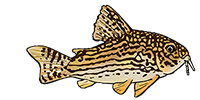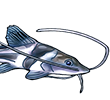A couple of points from this paper:
Although not mentioned in the abstract, the catfish species in this case was not confirmed. But this is what the writer had to offer:
LeBlond, 2019 wrote:The patient did not specify which type of catfish “bit” him, but he presented to an emergency department in the mid-south of the United States stating he was injured locally, which limits species to the channel, blue, and flathead catfish in freshwater.
Also, there's an interesting comment at end of the paper. Here is the closing paragraph, reviewing how any catfish injury should be treated. Pay attention to the last sentence:
LeBlond, 2019 wrote:Catfish injury treatment depends on injury type and severity. The injury site should be examined for abrasions, lacerations, and puncture wounds, and a neurovascular examination should be performed. Injuries can be caused both by the fish anad environmental hazards such as hooks, bacteria and viruses in the water and fish, metal, and vegetation. Evaluation for foreign bodies such as spines and hooks should be undertaken with radiographs, initially x-rays. Flushing the wound with normal saline and debridement of necrotic tissue should be undertaken with the administration of antibiotics. Any foreign bodies found should be surgically removed, and wounds should undergo closure by secondary intension or delayed primary closure. Tetanus prophylaxis, if indicated, should be administered. Wounds in freshwater should be treated with empiric antibiotic coverage because of the prevalence of both gram-positive and gram-negative bacteria. Sites of envenomation from catfish spines should also be immediately immersed in hot water (45°C) for 30 to 90 min because toxins tend to be heat-labile. (emphasis added)
I wonder how universally true it is that catfish toxins tend to be heat labile.
Cheers, Eric







